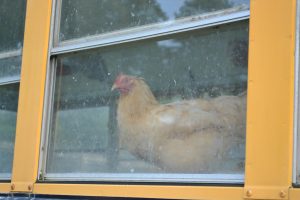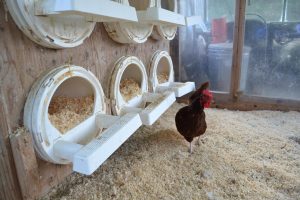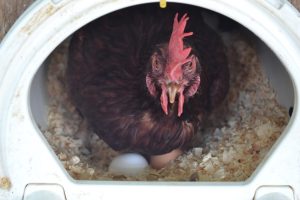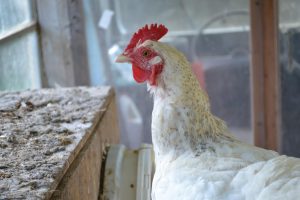By BRAD JOYAL
As the season turns and temperatures begin to drop, backyard poultry aficionados are springing into action. This is crunch time for them. This is when they get serious, batten down the hatches and get their chicken coops in order ahead of the coldest months of the year.
 A hen will lay an egg each day if properly cared for, a proposition that requires backyard poultry farmers to be attentive during the offseason. Like humans, chickens aren’t keen on brisk weather. They don’t like wind creeping through cracks in their doors and windows, and they yearn for warm, bright sunshine to brighten their days. In order to ensure a chicken will be comfortable and productive throughout the winter, it’s critical that owners are focused and proactive during the coldest months.
A hen will lay an egg each day if properly cared for, a proposition that requires backyard poultry farmers to be attentive during the offseason. Like humans, chickens aren’t keen on brisk weather. They don’t like wind creeping through cracks in their doors and windows, and they yearn for warm, bright sunshine to brighten their days. In order to ensure a chicken will be comfortable and productive throughout the winter, it’s critical that owners are focused and proactive during the coldest months.
“The most important thing is the building and the cage,” said Mike Abell, a Teaticket resident who raises and sells chickens in his backyard. “If you want chickens, you have to commit to that before buying animals. Anybody can go down the road and buy a chicken, but you don’t want to be keeping it in your kitchen because you waited to build its shelter outside.”
 If backyard chicken coops could be compared to hotel chains, it’d be fair to say Mr. Abell owns a Ritz Carlton. His school bus chicken coop is the perfect setting for hens, particularly during the winter months. The bus is lined with windows along its sides that provide Mr. Abell’s chickens with plenty of sunlight, and its secure placement off the ground is the perfect defense from wildlife looking for their next meal. “Nothing is getting in there,” Mr. Abell said.
If backyard chicken coops could be compared to hotel chains, it’d be fair to say Mr. Abell owns a Ritz Carlton. His school bus chicken coop is the perfect setting for hens, particularly during the winter months. The bus is lined with windows along its sides that provide Mr. Abell’s chickens with plenty of sunlight, and its secure placement off the ground is the perfect defense from wildlife looking for their next meal. “Nothing is getting in there,” Mr. Abell said.
Every backyard farmer has a preferred setup for his or her coops. Mr. Abell’s space allows him to house hundreds of chickens, though he acknowledges most people can get by with a much smaller structure.
“The golden rule is like a shed,” he said. “Each chicken only requires a couple square feet, so a little shack can handle five birds.”
 Building a shed might sound easy enough, but keeping chickens warm and comfortable is a much taller task. In order for hens to lay an egg every day, they must keep a schedule and be well fed. Many owners insert lights in their coops during the winter to help their chickens wake up before the sun rises, which guarantees they’ll keep an eating schedule that will lead to results.
Building a shed might sound easy enough, but keeping chickens warm and comfortable is a much taller task. In order for hens to lay an egg every day, they must keep a schedule and be well fed. Many owners insert lights in their coops during the winter to help their chickens wake up before the sun rises, which guarantees they’ll keep an eating schedule that will lead to results.
“If they’re eating, eating, eating, they’ll lay an egg,” Mr. Abell said. “Normally, you have to turn a light on at 4 AM until sunrise so they’ll eat for 12 hours. If they eat from 4 AM until sunset, they’ll lay an egg. Without a light, they wouldn’t get up until 7 AM and they’d only have eight or nine hours of feeding.”
Mr. Abell has grains available on his bus, allowing his chickens to snack as they please throughout the day. Some owners use food as a way to garner extra affection from their hens, and nothing pleases chickens more than warm oatmeal on a frigid winter day. Some owners willing to go the extra mile will line the coops with blankets during the winter. Although that might give chickens an extra layer to get cozy in their coops, Mr. Abell noted that blankets can cause additional cleanup duties for farmers.
“It’s just messy,” he said. “Shavings are the best thing because it’s easy to clean. If you use hay or stray, they poop and stink and that’s what brings the rats in. The shavings keep things drier. A blanket keeps things wet and nasty. The cleaner things are, the cleaner it is for you and the easier it is to get the eggs.”

Mike Abell shows off one of his chickens in his converted school bus coop.
Owners will want to be paying attention to their hens’ eggs in frigid weather because there is a risk they can freeze or crack. When it gets really cold, farmers will also want to make sure their chickens aren’t exposed to any wind.
“If something like a window or door was kept open and the wind was blowing in, they can get frostbite,” Mr. Abell said. “All it takes is a small area for them to get frostbite, so you have to seal the coop really good.”
Some backyard chicken fanatics go so far as to run an incandescent bulb in their coops at night or longer in really low temperatures to keep their chickens happy and producing eggs.
Safeguarding the coop will also keep predators away. Chickens can typically roam in a yard during the day—they’ll even strut around in the snow if it’s not too deep—because they’ll look after each other. If one sees a hawk plotting an attack from above, they’ll make noises to alarm each other before taking shelter. Hens are much more susceptible to attacks at night, especially if other critters are able to break into a coop.
“The first thing I tell people is, ‘Bulletproof your place,’ ” Mr. Abell said. “Make sure it’s ready, because one bad night is all it takes to lose them all.”
 Mr. Abell said predators attack in different ways. A racoon, for instance, will kill every last chicken. According to Mr. Abell, racoons aren’t killing chickens to eat them—they simply enjoy the chase and have no reservations about transforming a coop into a bloody massacre. Foxes are much more subtle. They’ll scoop up a chicken without any sign of foul play. “A fox won’t leave a feather or anything,” Mr. Abell explained.
Mr. Abell said predators attack in different ways. A racoon, for instance, will kill every last chicken. According to Mr. Abell, racoons aren’t killing chickens to eat them—they simply enjoy the chase and have no reservations about transforming a coop into a bloody massacre. Foxes are much more subtle. They’ll scoop up a chicken without any sign of foul play. “A fox won’t leave a feather or anything,” Mr. Abell explained.
The best way to prevent attacks it to have a shelter off the ground, if possible. Attached to Mr. Abell’s bus is a raised outdoor pen that his hens can access through a small opening in the back of the bus, similar to a dog door cut into a door. Not only does a raised coop keep predators away from the hens and the hens’ food, it also makes Mr. Abell’s cleanup much simpler.
“The pen just keeps them cleaner,” he said. “If the pen is on the ground, it’s going to collect a lot of mud. Every rain storm, you’ll wish you never went in there.”
Like keeping a coop well-lit and warm, Mr. Abell stresses that the right amount of cleanliness is also essential to the operation.
 “You can’t clean the coop or pen too much,” he said. “Their immune systems are built on their poop. If you keep the poop away from them, their immune systems will shut down. Ideally, you want it so it’s not too messy, but also not too clean at the same time.”
“You can’t clean the coop or pen too much,” he said. “Their immune systems are built on their poop. If you keep the poop away from them, their immune systems will shut down. Ideally, you want it so it’s not too messy, but also not too clean at the same time.”
Backyard chicken farmers who provide their hens with enough light and food to lay eggs each day can expect about 1,200 eggs in all. They’ll live for up to nine years, meaning owners will have a companion long after their hen has stopped producing eggs.
Many are happy to have chickens as pets, and Mr. Abell has noticed the majority of his customers are equally as thrilled about gaining new pets as they are having a supply of eggs. Still, even though he understands many people might view raising backyard chickens as a fun and entertaining responsibility, Mr. Abell is remindful that you really should be committed to the diet before giving it a shot.
“Unless you really love eggs, your neighbors are going to have them,” he said. “You’ll be all gung-ho for the first month. You’ll crack ’em, love ’em and eat ’em, but then, after a month you’ll be sick of eggs.”
Finding Your Amelia Egghart
According to the American Poultry Association and local expert Mike Abell, of the 50-plus recognized breeds of chickens, there are four in particular that are able to thrive in New England’s unpredictable, often cold winters.
 The Rhode Island Red, New Hampshire Red, Plymouth Rock and Buff Orpington are common northern birds that like the cold. However, Mr. Abell cautions, mixing and matching breeds can cause problems in the coop.
The Rhode Island Red, New Hampshire Red, Plymouth Rock and Buff Orpington are common northern birds that like the cold. However, Mr. Abell cautions, mixing and matching breeds can cause problems in the coop.
“The Buff Orpington and Plymouth Rock are a little bigger than the Rhode Island and New Hampshire Reds, so they tend to be a little more aggressive,” he said. “You like to keep the same size birds together so you won’t have bigger birds beating up the smaller ones.”
As the popularity of backyard chickens soars, so does the availability of colored eggs. From olive to blue and speckled to chocolate brown, they’re definitely a trend. Although the colors vary, Mr. Abell said he can’t tell a difference in the taste between colors. The color of the shell is merely decoration.
“They taste the same because they’re fresh, it’s just that farm eggs give you more of a variety in color,” he said. “Store eggs are much more consistent with their white color.”
Popular breeds that lay colored eggs include Barred Rock, Rhode Island Red, Ameraucana and Welsummer chickens.
You may also be able to tell the shell color by the hen’s earlobe. Hens with white earlobes typically lay white or lightly tinted eggs. Hens with red earlobes most commonly lay brown eggs, but there are always exceptions to those rules. Different shades of eggshells can come from the same bird on different days.
With the popularity in colors comes, to little surprise, popularity in naming backyard chickens. Not every owner does, but, in a completely unscientific poll of Upper Cape chicken aficionados, here are the top poultry monikers:
Albert Eggstein, Amelia Egghart, Attila the Hen, Chicken Little, Cluck Norris/Chick Norris, Dixie Chick, Yolko Ono, Princess Layer, Russell Crow, and, of course, Egg-bert. According to our, again, unscientific research, it would appear that chickens DO learn their own names.
Mr. Abell isn’t one for naming his own chickens, and says that in all of his years of selling chickens, he’s found that most of his customers are most eager to get them home.
“It’s just the enjoyment of seeing them in the yard,” he said. “People love watching them.”
Word of caution, however: if you like to cuddle your chickens (yes, many of them love to be cuddled), be careful to properly and thoroughly wash your hands and clothes afterward to prevent salmonella exposure.

